| EQUINETOURISM - HORSE BREEDS - The Purebred Spanish Horse |
| Horses of the World - The Purebred Spanish Horse (PRE) |
The Purebred Spanish Horse or P.R.E. (Pura Raza Espanola) is many things to many people - a legendary show horse, a dressage horse, a hack, a driving horse, a jumping horse and a cross-country horse. He is a breathtakingly beautiful horse and has the ability to enhance and empower many other breeds of horses when his blood is introduced. Anyone owning a P.R.E. will tell you that, once you have opened the door into this world of equestrianism, it is one which you will rarely ever close.
By kind permission of the British Association for the Purebred Spanish Horse www.bapsh.co.uk
|
|
|
|
The History of the Purebred Spanish Horse
The ancestry of the Spanish (Andalusian) horse originated in Paleolithic times. During this prehistoric era there were 3 distinct groups of horses, one of which was to become the Iberian horse from the area which we now know as the southern part of the Spanish/ Portuguese peninsula.
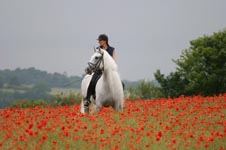
Above: Photo in poppy field, Kent - Permission of Phil Stewart
Although the landmass was significantly different and allowed for huge migrations of horses across the continents; scientific evidence shows a genetic route can be traced to animals which carried the characteristics we now see in the modern purebred Spanish horse, or Pura Raza Espanola (P.R.E.). This is the horse which is still bred in and around the delta of the Rio Guadalquivir and whose popularity has spread worldwide.
History bears testament to three important issues which have had a constant influence on Spanish horses. There has long been a correlation between the desire to guard the strongly well-maintained bloodlines and the reverence which was paid to Spanish horses by many members of the continental Royal families. Successive warring European nations became aware of the advantages during battle of being mounted upon a nimble, athletic but ultimately brave horse.
It is known that the Visigoths succeeded the Romans into Spain and that the routes of selective breeding began around 400 a.d. In the eighth century a.d., the greatest civilizing force took place with the Muslim invasion. With 800 years of influence, the Emirs, who brought the Arab and Barb horses with them, were eager to preserve their own breeds but the indigenous horse was also revered.
When the Christian armies arrived on their heavier horses they found to their cost that they were hugely disadvantaged. Nevertheless, it was only towards the end of the Crusades which saw the invaders realizing that the noble Andalusian was without equal.
Royalty
The legendary ability of these horses spread around Europe and in 1571 Philip the Second started the first royal stud at Cordoba. With Spain on a constant war footing, great inducements were given to breeders to breed sound stock and within a short period of time the Andalusian had become a popular status symbol. Royal interest and patronage assisted the development of studs and the breed progressed into the next century with these animals being eagerly sought by Kings from other countries.
The Carthusian InfluenceSimultaneously the Carthusian monks of Jerez devoted themselves to horse breeding from the end of the 15th century and created a program which eliminated any outside influence upon their stock. Their commitment and dedication saw their horses become highly esteemed due to the inherent purity of their animals.
All breed societies recognise the absolute necessity for a studbook as a record for essentially maintaining the purity of the breed; and which creates a standard for the future. Not all the Royals at this time employed the criteria which the Carthusian monks believed would keep the blood pure; and they therefore kept rigid control over the bloodlines of the horses that they bred. They received a gift of ten thousand acres of land in Jerez which allowed them control of their own stock without outside influence. The high standards have continued at this stud even after the authority of the Monks has ceased.
Recently...
Today, a ‘Carthusian’ horse is a reference to this continuing influence which exists due to EXPASA, Agricultura y Ganaderia, a company which comes under the auspices of Spain’s State Heritage department; and which is now the proprietor of what was and still is, one of the most influential Spanish horse breeding farms – La Yeguada de la Cartuja.
The overall control of the Spanish horse stud book was, for many years, the responsibility of the Jefatura de Cria Caballar (FESCCR), a cavalry branch of the Spanish Government’s military. The strict breeding control saw delegations traveling around the world, inspecting, grading and judging Spanish horses. Gradually, the breed was becoming much more than a working and ceremonial horse and the world became acutely aware of the breed’s competition status.
A.N.C.C.E. and SICAB
Today, the governing body responsible for the administration of the Stud Book for the Purebred Spanish Horse and which is the only one officially recognised by Spain’s Ministry of Agriculture, has passed into the hands of A.N.C.C.E. – the National Association of Purebred Spanish Horse Breeders of Spain. They are also responsible for organising the Qualified Breeding Stock events and the Young Horse Dressage competitions.
The most important event at which the overall Championships take place is SICAB in Seville, at the Palacio de Exposiciones y Congresos de Seville. This is also a yearly showcase and trade fair held during November and organised by A.N.C.C.E. Over 125 stud farms bring something in the region of 1,200 horses to compete for such prestigious prizes as the Spanish National Confirmation Championships, the ANCCE Dressage Cup and the Doma Vaquera Cup. Spectacular equestrian performances take place every evening of this 6 day show and is a ‘must see’ for anyone with even a passing interest in the Spanish horse.
Disciplines
In Spain, the prowess of the Spanish Horse is still seen in the bullfighting arena and as a working horse who can carry a man to work among his cattle stock. He is usually trained to a degree of horsemanship which can be life-saving. From this place has derived the art of Doma Vaquera – a competition in which a series of complicated movements are carried out by horse and rider and judged accordingly, similar to some ways to our dressage but way beyond the elementary level and always ridden in vaquera tack and costume with the reins held only in the left hand.
His international success in the conventional dressage arena has placed him in the equestrian limelight where he has, for some time, been seen as a serious competition horse. In the U.K. there is a number of P.R.E.’s steadily working their way up to the highest levels of dressage.
The P.R.E. is many things to many people, a show horse, a dressage horse, a hack, a driving horse, a jumping horse and a cross-country horse. Endurance riding, Le Trec, working equitation and doma vaquera are other perhaps less well-known disciplines in the U.K at which he excels. However, he will always remain a breathtakingly beautiful horse for displays; as well as a talented and versatile member of the equine family.
The Purebred Spanish Horse has the ability to enhance and empower so many other breeds of horses when his blood is introduced, but that’s another story!
Anybody owning a P.R.E. will tell you that once you have opened the door into this world of equestrianism, it is one which you will rarely ever close.
|
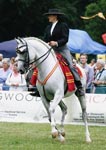
Zurito – Stallion (Zuti) owned and ridden by Lorri Ould. Competes in dressage, English & Spanish Showing, Parades and takes part in displays and demonstrations. Bred by Diane Carter (nee Hesketh)
Sire Conquistador VII
out of Carinosa II
Above: Ellingham Show – Parade Class
Photo permission of Phil Stewart
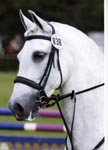
Andaluza - mare with a beautiful head showing the slightly more refined view of the feminine Spanish horse.
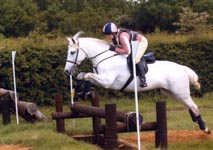
Andaluza (Lucy) - mare owned and ridden by Sally Bullar. Competes in dressage, showjumping, one-day events, Showing and Riding club displays. Bred at Rancho la Paz, Fuengirola by
Sire Novelero IX out of Esplendida
Photo permission of Matt Sewell-Rutter Ardingly Horse Trials.
Balastro – carrying Spanish side-saddle.

Balastro – Stallion (Bubba) owned and ridden by Caroline Clinkard. Competes in dressage, showing and parades. Carries side-saddle and is used ‘al la grupa’ (carry a lady behind). Bred by Jose Maria Fernandez de la Vega y Sedano
Sire Almendrito II out of Voluble
Photo by kind permission of Horsepower
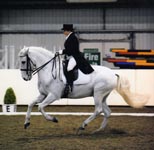
Orfebre – Gelding (Chico) owned and ridden by Fiona Foy. Orfebre takes part in displays and demonstrations and competes in dressage. Qualified every year since 2001 for BD Regional Dressage Finals. Competing at P.S.G. Bred by Jane McCutcheon
Sire Euclides out of Inrtrusa VI
Photo by kind permission of Kevin Sparow 07917 336694 [email protected]
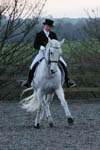
Orfebre - performing half-pass

Above: Ileana III – Mare owned by Greg Simpson. 7th in the G.B Le Trec Championships. Bred by Tina Barnet-Tucker
Sire Lebrijano IX out of Judia VII.
Photo by permission of Greg Simpson
|
| Photographs by kind permission from The British Association for the Purebred Spanish Horse. Lorri Ould is the copyright holder for this article, Spanish Horse Profile. All rights are reserved. No part may be published or reproduced or transmitted without prior consent of the copyholder. |
| Breed Conformation - The Purebred Spanish Horse |
An Aristocratic...
Much has been written about the conformation of arguably one of the most beautiful horse breeds in the world. Unfortunately, words do not do this horse justice at all! To this day, a perfect horse, conformation-wise, has yet to be born. However the P.R.E. is an equine example which, as a riding horse, often comes very close indeed.
There is nothing coarse or heavy about the Spanish horse, the overall pictures is of balance and power with a hint of arrogance.
Overall: Starting with the broad forehead; eyes - diamond-shaped, completely dark and clear, full of expression and intelligence, surrounded by delicate lashes, a tapering nose with fine lips and a flexible muzzle. This moves on towards well developed gaskins with strong and flexible hocks carried beneath a full and luxurious tail. From beginning to end the Spanish horse exudes magnificence. Seen from the side, his head should not be convex, it is long and aristocratic, covered in fine hair and thin skin. Viewed from the front, the eyes are set well down from the base of the ears which form a balance of proportion narrowing through to his muzzle which gives this horse a noble
demeanour.
Spanish foals are usually born with a natural self-carriage and a delicate arch to their necks – a neck which should never become thick or over develop into a lower convex profile. Neither should it be long or wide with a thickened crest.
Ears which are active and alert, not too well set together nor touching at the ends but which form a definite curve from base to tip. There should always be an existing balance between the length of neck and length of leg and a flexibility of the neck and head axis which allows for the Spanish horse to be able to work on the bit very easily.
The shoulders should be sloping but without placing the withers too far back. Neither should they be straight which produces a shortened stifled step. The withers, acting as the structure which unites the front of the horse to the rear, should be proportionate to the length of back, neither too low, causing the horse to move ‘downhill’ or too high. With the correct conformation, they should allow the rider to sit reasonably well back where his weight will be carried efficiently. As the Spanish horse has evolved to cope with diverse terrain, his shoulders should be long and sloping with his forelegs set well behind his chest.
The Legs As with any horse, the forelegs carry the majority of weight and therefore any defect will adversely impinge on the horses’ ability to carry out his work and he will be prone to lameness and possibly be forehand-heavy. Fortunately, the Spanish horse (if not overworked too young) is blessed with sound limbs, strong hooves and dense bone. His legs should be slender, but not fine, well muscled with hard smooth knees.
At one time, it was fashionable for some Spanish horses to ‘dish’ – an action which allows the forelegs to swing outwards from the knee. This has largely been eradicated and was only ever really encouraged in horses which were used in showy parades and ferias. Today, the knowledgeable breeder understands the gross strain this movement places on the horse which is using an uneconomical amount of energy to produce this action. We therefore now see the majority of Spanish horses with good straight movement.
Without a large enough area for the heart and lungs a horse will have limited stamina, the Spanish horse should have a deep chest and a generous (but not excessively wide) space between the forelegs. More importantly his ribs should be oval and well sprung giving the rider the optimum area on which to balance comfortably in each gait.
The ability of the Spanish horse to lower his haunches and raise his forehand in ‘collection’ is well-known. It is therefore unacceptable for him to be long in the back, this will cause him to be weak. However, if too short he will easily overreach and not provide a comfortable ride. His back is broad and not excessively dipped. His loins should be strong and they should smoothly flow into a croup which is not high. The croup and rump should give the impression of being rounded from behind and sloping, from the side, with no discernable points or bumps.
An important feature of the Spanish horse is his tail and how he carries it. It should be robust and follow the line of the croup, being set somewhat lower than that of an Arab horse. It should be carried freely in movement but not away from the haunches (as in the Arab); it should fall straight and be luxuriant in texture.
The hind legs of the Spanish horse, as in any equine, carry the responsibility of driving the horse forwards and good conformation is required for soundness and ease of movement. Obvious defects like cow-hocks, bow-legs and general disproportional lengths between the tibia and cannons are not tolerated in the breed. Generally speaking a Spanish horse should stand with his hind legs squarely supporting his weight, neither too far out from his body mass nor slanted inwards, as in sickle hocks.
The thigh and gaskins should not look thick but appear smooth and muscled. His hocks should be broad when viewed from behind and never ‘tied in’. His cannons should be slightly rounder than in the forelegs but viewed from the side they should share a comparison.
In essence, a Spanish horse will be flawless in terms of conformation defects. In movement he will exude power, cadence and natural rhythm. He will have the ability to lengthen and shorten his stride and still move with fluidity.
Temperament The Spanish horse is, by nature a balanced and intelligent creature. He is willing to please, forgiving and generous. There are of course variations in temperament ranging from docile and placid to rather more highly strung but largely his disposition is level-headed and tolerant. If handled correctly he will remain well-mannered if kept as a stallion.
Colours and Coat At present the PRE studbook allows for all colours except piebald and skewbald, however, the predominant colours are grey, bay and black. The texture of the coat should be smooth and fine with the mane and tail abundant, giving a full and lush impression.
|
| For More information |
| The B.A.P.S.H (British Association for the Purebred Spanish Horse)
Here in the U.K. registered studs and ownership of the P.R.E. are increasing under the auspices of the British Association for the Purebred Spanish Horse (B.A.P.S.H.). They ensure that the highest standards with respect to the breed are maintained. This is only ever possible if breeding stock is selected and graded in line with the guiding principles set down by A.N.C.C.E. and which have been carefully endorsed and adhered to for hundreds of years.
http://www.bapsh.co.uk
The registered Office of BAPSH Ltd is: 32 Barton Street, Bath BA1 1HH.
Other Equinetourism.co.uk section which may be of interest:
Classical Riding
Dressage
Spain Horse Holidays
|
| For more information about advertising on Equinetourism.co.uk, please click here |
BACK TO EQUINETOURISM.CO.UK WORLDWIDE HORSE HOLIDAYS FRONT PAGE
|
|
 Horse riding holidays, equestrian events and shows, horseback vacations, equine directory, good horsemanship, horse holidays, uk and worldwide
Â
ADVERTISE on Equinetourism.co.uk - Click here
SEARCH FOR CONTENT ON EQUINETOURISM.CO.UK |
Also see www.EquineTourismCommunity.com and www.EquineTourism.com
email: [email protected] - Telephone 00 44 (0)1643 862785
www.EquineTourism.co.uk is owned by Happy Horses Ltd, Holt Ball, Luccombe, Minehead, Exmoor, Somerset TA24 8SZ
Full worldwide copyright and all rights retained ©2004-2014 ongoing Happy Horses Ltd. Please read our Disclaimer
|
